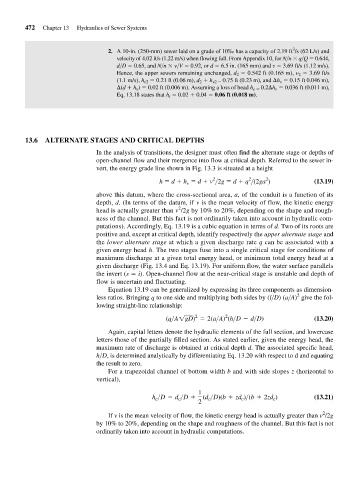Page 514 - Fair, Geyer, and Okun's Water and wastewater engineering : water supply and wastewater removal
P. 514
JWCL344_ch13_457-499.qxd 8/7/10 8:49 PM Page 472
472 Chapter 13 Hydraulics of Sewer Systems
3
2. A 10-in. (250-mm) sewer laid on a grade of 10‰ has a capacity of 2.19 ft /s (62 L/s) and
velocity of 4.02 ft/s (1.22 m/s) when flowing full. From Appendix 10, for N>n q>Q 0.644,
d>D 0.65, and N>n v>V 0.92, or d 6.5 in. (165 mm) and v 3.69 ft/s (1.12 m/s).
Hence, the upper sewers remaining unchanged, d 2 0.542 ft (0.165 m), v 2 3.69 ft/s
(1.1 m/s), h v2 0.21 ft (0.06 m), d 2 h v2 0.75 ft (0.23 m), and h v 0.15 ft 0.046 m),
(d h v ) 0.02 ft (0.006 m). Assuming a loss of head h e 0.2 h v 0.036 ft (0.011 m),
Eq. 13.18 states that h i 0.02 0.04 0.06 ft (0.018 m).
13.6 ALTERNATE STAGES AND CRITICAL DEPTHS
In the analysis of transitions, the designer must often find the alternate stage or depths of
open-channel flow and their mergence into flow at critical depth. Referred to the sewer in-
vert, the energy grade line shown in Fig. 13.3 is situated at a height
2
2
2
h d h v d v >2g d q >(2ga ) (13.19)
above this datum, where the cross-sectional area, a, of the conduit is a function of its
depth, d. (In terms of the datum, if v is the mean velocity of flow, the kinetic energy
2
head is actually greater than v /2g by 10% to 20%, depending on the shape and rough-
ness of the channel. But this fact is not ordinarily taken into account in hydraulic com-
putations). Accordingly, Eq. 13.19 is a cubic equation in terms of d. Two of its roots are
positive and, except at critical depth, identify respectively the upper alternate stage and
the lower alternate stage at which a given discharge rate q can be associated with a
given energy head h. The two stages fuse into a single critical stage for conditions of
maximum discharge at a given total energy head, or minimum total energy head at a
given discharge (Fig. 13.4 and Eq. 13.19). For uniform flow, the water surface parallels
the invert (s i). Open-channel flow at the near-critical stage is unstable and depth of
flow is uncertain and fluctuating.
Equation 13.19 can be generalized by expressing its three components as dimension-
2
less ratios. Bringing q to one side and multiplying both sides by (l>D) (a>A) give the fol-
lowing straight-line relationship:
2
2
(q>A1gD) = 2(a>A) (h>D - d>D) (13.20)
Again, capital letters denote the hydraulic elements of the full section, and lowercase
letters those of the partially filled section. As stated earlier, given the energy head, the
maximum rate of discharge is obtained at critical depth d. The associated specific head,
h>D, is determined analytically by differentiating Eq. 13.20 with respect to d and equating
the result to zero.
For a trapezoidal channel of bottom width b and with side slopes z (horizontal to
vertical),
1
h >D = d >D + (d >D)(b + zd )>(b + 2zd ) (13.21)
c
c
c
c
c
2
2
If v is the mean velocity of flow, the kinetic energy head is actually greater than v /2g
by 10% to 20%, depending on the shape and roughness of the channel. But this fact is not
ordinarily taken into account in hydraulic computations.

